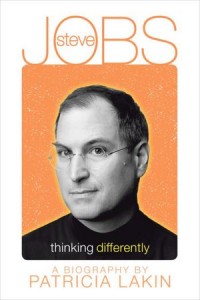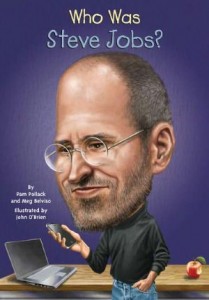 Steve Jobs: Thinking Differently, by Patricia Lakin. Aladdin (Simon & Shuster), 2012, Age/interest level: 10-14.
Steve Jobs: Thinking Differently, by Patricia Lakin. Aladdin (Simon & Shuster), 2012, Age/interest level: 10-14.
Who Was Steve Jobs? by Pam Pollack and Meg Belviso, illustrated by John O’Brien. Grosset & Dunlap, 2012, 105 pages. Age/interest level: 8-12.
“I started thinking that maybe Thomas Edison did a lot more to improve the world than Karl Marx and Neem Kavoli Baba put together.” That was the young Steven Paul Jobs, ca. 1972, after a sojourn in the country that had captured his spiritual imagination. India was not Nirvana—with its filthy, overcrowded streets, ragged children, and disease-ridden slums, it wasn’t even Cleveland. So Steve went home, and fifty years later people were making statements about him similar to what he’d said about Thomas Edison.
There was probably more of America in Jobs than even he realized. “Only in America” could a habitually barefoot, seldom-bathed college dropout convince enough people to fork over enough money to start a computer business—not in his garage, as is commonly claimed, but in his partner’s kitchen. Then they moved to the garage, and it wasn’t Steve’s but his dad’s. Whatever the venue, it was the right place at the right time, and having a sense of “rights” is more a matter of vision than genius—or maybe genius and vision are not that far apart.
When Steve Jobs died last October, Walter Isaacson’s biography was rushed into print and became an immediate best-seller. Patricia Lakin’s biography for children appeared in February and Grosset & Dunlap added Jobs to their “Who Was . . .” series of biographies at the same time. I know of at least two comic-book versions. So the interest in this particular life is still high, and rightly so: he really did change the world. Not entirely for the better, but technology usually involves trade-offs. Since I didn’t know that much about him, these two biographies were not only informative but also insightful about the secrets of his success. Such as . . .
 The importance of family, especially father: As everybody knows now, Steve was adopted as a baby by Paul and Clara Jobs, who provided not only stability but also example. Paul Jobs was a hands-on guy who taught his son how to tinker with tools and machines, thereby creating a sense of capability. Later on, when Steve was building his first line of Apple computers, his parents provided support, free labor—and the garage, of course.
The importance of family, especially father: As everybody knows now, Steve was adopted as a baby by Paul and Clara Jobs, who provided not only stability but also example. Paul Jobs was a hands-on guy who taught his son how to tinker with tools and machines, thereby creating a sense of capability. Later on, when Steve was building his first line of Apple computers, his parents provided support, free labor—and the garage, of course.
The head/hand connection: Steve learned from his dad how to fix things, and was never afraid to get his hands dirty. This is something our academically-oriented education system is trying to forget—high schools are eliminating shop class and selling their power tools. Education is seen as a matter of intellect only. But humans are integrated beings, and our practical skills complement our head knowledge; one needs the other.
Attention to detail: dropping out of college after one semester, Steve stayed on to take courses that interested him. One of those courses was calligraphy, which attracted him by its beauty. Taking time to practice isolated strokes and shape the letters taught him to pay attention to the parts that make up a whole—and what some technicians later saw as arbitrary (such as the housing for the computer) Steve saw as essential to the whole machine.
Finding and following your interests: Steve had many interests, such as calligraphy and geography and eastern religions systems, but his passion for electronics appeared early, and he was in the right place (Silicon Valley) to explore it. Most kids either don’t know what they’re interested in, or they go through a series of interests throughout childhood and adolescence. And that’s fine. But the most successful people—at least as “success” is usually measured—tend to find their passion fairly early in life.
Biography is one of the most instructive forms of literature, especially for kids. To the limited extent that we can really know a man, his choices, advantages, and character qualities can teach us to examine our own. Both these biographies, while not works of literature, offer enough insight about Jobs’s life and character to raise interesting questions. Such as 1) What kind of influence did his father have on him? 2) What do you see as the key ingredient of his success? 3) How did he handle rejection by the company he founded? 4) Since he didn’t actually invent any of the machines or components that made the Apple product line, why is he considered the genius behind Apple? 5) If there were no Steve Jobs, would we still have iPhones? And finally, 6) How would you (and other people in your family) define success?
Public lives open themselves to public scrutiny. As long as we understand that we can only delve so far, there are lessons to be learned.
When talking about biography, there’s no better introduction than Cheryl Harness, whose “Cheryl Harness Histories” are reviewed here.
Support our writers and help keep Redeemed Reader ad-free by joining the Redeemed Reader Fellowship.
Stay Up to Date!
Get the information you need to make wise choices about books for your children and teens.
Our weekly newsletter includes our latest reviews, related links from around the web, a featured book list, book trivia, and more. We never sell your information. You may unsubscribe at any time.
We'd love to hear from you!
Our comments are now limited to our members (both Silver and Golden Key). Members, you just need to log in with your normal log-in credentials!
Not a member yet? You can join the Silver Key ($2.99/month) for a free 2-week trial. Cancel at any time. Find out more about membership here.
1 Comments
Leave a Comment
You must be logged in to post a comment.


Interesting. I haven’t heard the first thing about these books, but I think I’d like my girls to read about him eventually. I’m not going to be able to teach them very much about manual labor–beyond laundry and lawn mowing, at least. I hope reading about some scientific folks, in conjunction with some good science classes, might help bridge the gap.